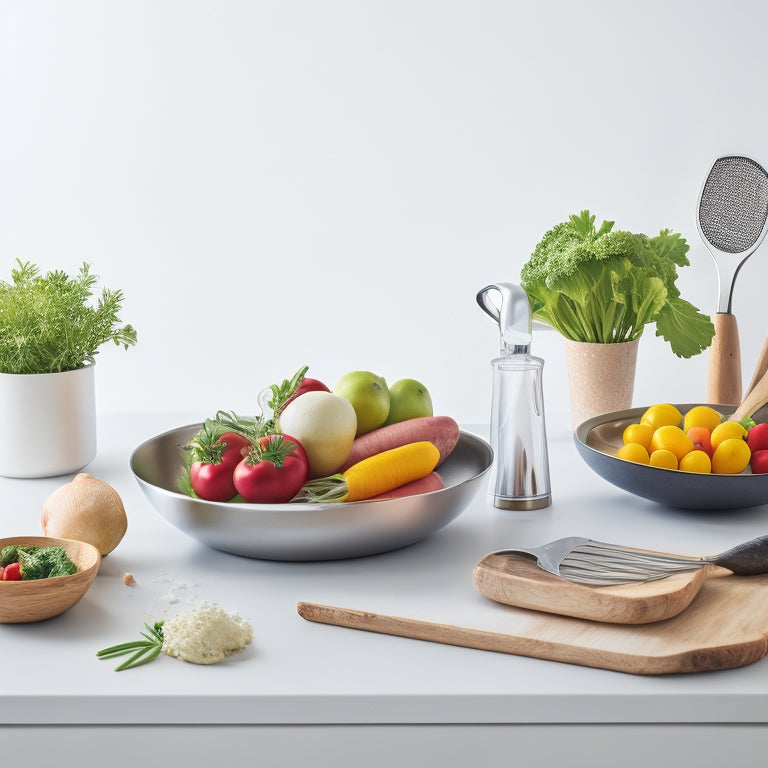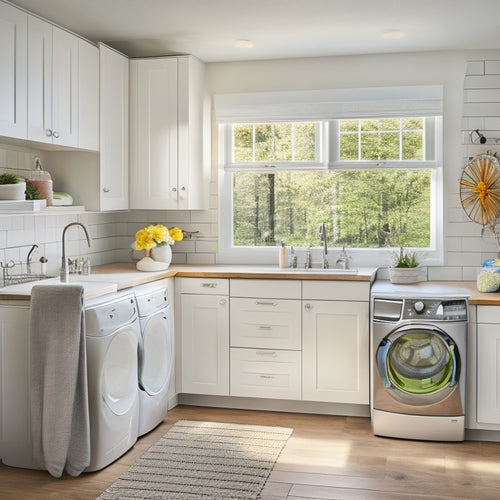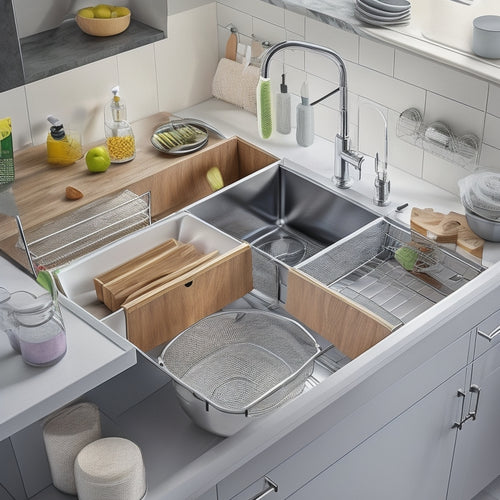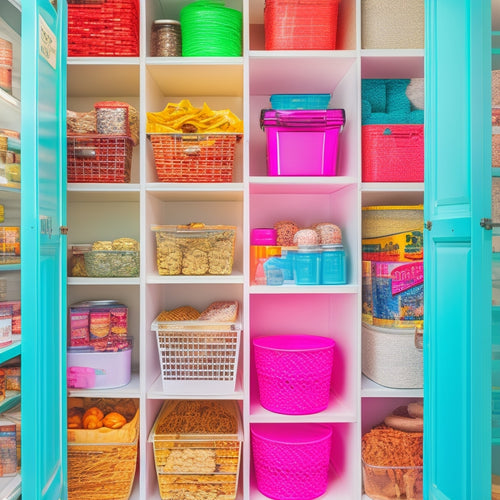
Simplify Your Kitchen: Decluttering Essentials
Share
You're about to transform your kitchen into a haven of efficiency and serenity by streamlining your countertops, cabinets, and storage spaces. Start by tackling 'hot zones' like countertops and cabinets, optimizing layouts, and categorizing items into zones. Next, purge unwanted items by gathering, sorting, and eliminating duplicates, broken items, and unused gadgets. Then, organize kitchen utensils and gadgets into baking, cooking, and serving categories, and utilize tool trays and gadget grids for efficient storage. Finally, manage kitchen cords and cables using cord organizers and maximize corner space with shelves and angle optimizers. Now, you're ready to create zones for kitchen tasks and discover the secrets to a truly simplified kitchen.
Key Takeaways
• Tackle cluttered areas like countertops and cabinets to create a functional space by categorizing items into zones and implementing storage hacks.
• Purge unwanted items by eliminating duplicates, broken items, and unused gadgets to free up space and reduce clutter.
• Organize kitchen utensils and gadgets by sorting them into categories, utilizing tool trays, and storing less-used items in stackable containers.
• Manage kitchen cords and cables by using cord organizers, routing them behind appliances, and designating a charging area to maintain tidiness.
• Create zones and storage spaces for specific tasks, such as a cleaning station, sanitation station, and baking zone, to maximize efficiency and reduce clutter.
Decluttering Kitchen Countertops and Cabinets
Begin by tackling the 'hot zones' in your kitchen - the countertops and cabinets that have become cluttered with everything from appliances and gadgets to cookbooks and snacks. Optimizing your Countertop Layout is crucial to creating a functional and peaceful cooking space.
Start by categorizing items into zones, such as a baking station or coffee corner. Assign a home for each item, ensuring it's easily accessible and visually appealing.
Next, focus on your cabinets. Implementing Cabinet Hacks like adjustable shelves, dividers, or baskets can help maximize storage and keep items organized. Consider a 'first in, first out' approach for storing food and ingredients, ensuring expired items are front and center. Label each cabinet and shelf to maintain your new system.
Purge Unwanted Kitchen Items First
Before you can organize your kitchen, you need to purge the unwanted items that are taking up valuable space.
Start by gathering everything from your countertops and cabinets, and then sort items into categories to identify what you can get rid of.
You'll be surprised at how many duplicates, broken items, and unused gadgets you've accumulated, and eliminating them will make a huge difference in your kitchen's functionality.
Get Rid of Duplicates
Purging duplicates is an essential step in streamlining your kitchen, and tackling this task first allows you to eliminate clutter quickly, freeing up space and reducing decision fatigue.
You'll be amazed at how much Double Trouble you've accumulated over the years - multiple sets of measuring cups, duplicate utensils, and identical cookbooks. It's time to break free from Kitchen Clutter and get rid of the extras.
Start by gathering all the duplicate items and sorting them into categories. Be honest with yourself - do you really need three garlic presses or five wooden spoons? Keep only your favorite or most-used items and consider donating or recycling the rest.
Identify Broken or Damaged
You're likely to uncover broken or damaged items as you sort through your kitchen, so take a closer look at each item and be ruthless about letting go of anything that's beyond repair or no longer serves a purpose. It's time to acknowledge that holding onto these items isn't only taking up valuable space but also creating clutter and stress in your kitchen.
Some common culprits include:
- Faulty appliances that no longer function properly or have been replaced
- Damaged cookware with chips, cracks, or rust that's no longer safe for cooking
- Kitchen gadgets with broken parts or worn-out components
- Expired or spoiled food and ingredients that are past their prime
Unused Items Take Space
Every kitchen has its share of unused items, from gadgets that seemed like a good idea at the time to cookbooks that haven't been cracked open in years, taking up valuable space and contributing to clutter. These items not only occupy physical space but also affect your mental clarity. According to Storage Psychology, cluttered spaces can lead to feelings of anxiety and overwhelm. It's time to break free from the clutter cycle and create a more peaceful kitchen environment.
You must be honest with yourself – if you haven't used it in the past year, you probably won't miss it. Be ruthless when it comes to purging Space Wasters from your kitchen. Get rid of duplicate items, broken appliances, and gadgets that no longer serve a purpose.
By letting go of these unused items, you'll create space for the things that truly matter. You'll also reduce decision fatigue and make meal prep more efficient. Remember, a clutter-free kitchen isn't only more aesthetically pleasing, but it also promotes a sense of calm and well-being.
Take control of your kitchen and start purging those unwanted items today!
Organize Kitchen Utensils and Gadgets
Sort your kitchen utensils and gadgets into categories, such as baking, cooking, and serving, to create a functional and accessible storage system. This will help you quickly find what you need when you need it, reducing stress and increasing productivity in the kitchen.
To maximize your storage space, consider using:
-
Tool trays to store frequently used utensils, like spatulas and whisks, near your main cooking station.
-
Gadget grids to organize smaller items, such as garlic presses and lemon juicers, on a wall or inside a cabinet.
-
Stackable containers to store less frequently used items, like specialty baking tools or infrequently used gadgets.
- A utensil organizer near your sink to keep dishwashing essentials, like sponges and scrubbers, within easy reach.
Tame Kitchen Cords and Cables
Kitchen counters and drawers can quickly become cluttered with cords and cables from appliances, gadgets, and charging devices, making it difficult to find what you need and creating an eyesore. To tame the chaos, implementing effective cord concealment and cable management strategies is crucial.
Here are some ideas to get you started:
| Cord Concealment Ideas | Cable Management Tips |
|---|---|
| Use cord organizers or zip ties to keep cords tidy | Designate a specific area for charging devices |
| Route cords behind appliances or along baseboards | Use adhesive-backed cable clips to secure cables |
| Invest in a cord concealer or cable management box | Label cords and cables for easy identification |
Maximize Corner Space Efficiency
You can free up valuable storage space by addressing the often-wasted corners of your kitchen, where countertops and walls intersect. These areas often become dead zones, collecting dust and clutter. By maximizing corner space efficiency, you can create a more organized and functional kitchen.
Here are some ways to optimize your kitchen corners:
-
Install Corner Shelves to store infrequently used items, such as special occasion dishes or cookbooks.
-
Use Angle Optimizers, like carousels or lazy susans, to make the most of the space and allow easy access to items in the back.
-
Consider a corner sink or cooktop to create a more streamlined workflow.
- Add a pull-out trash can or recycling bin to keep waste management out of the way.
Create Zones for Kitchen Tasks
When simplifying your kitchen, it's crucial to create distinct zones for different tasks. You'll want to identify areas where you'll prep ingredients, cook meals, clean up, and store kitchen essentials.
Prepare Cooking Stations
Designate specific areas for food preparation, cooking, and cleanup to maximize efficiency and reduce clutter. By creating distinct zones for each task, you'll improve your cooking flow and make meal prep a breeze. This will also help you maintain a sense of control and calm in the kitchen.
Here are some key areas to focus on:
-
Meal prep zone: Designate a specific counter or table for food preparation, including chopping, slicing, and dicing. This will help keep ingredients organized and within reach.
-
Cooking station: Identify a central cooking area, such as a stovetop or cooktop, and keep frequently used cookware and utensils nearby.
-
Pantry and storage: Allocate a specific area for storing dry goods, spices, and cooking essentials. This will help keep your kitchen organized and make it easier to find what you need.
- Cleanup zone: Designate a specific area for cleaning and washing dishes, including a sink, dishwasher, and trash can. This will help keep your kitchen tidy and make cleanup a breeze.
Designate Cleaning Areas
When designating specific zones for kitchen tasks, such as cleaning, you'll create a sense of order and structure that makes maintaining a tidy kitchen a whole lot easier. This approach allows you to establish efficient cleaning routines and sanitation stations, making it simpler to keep your kitchen clean and hygienic.
Here are some zones worth designating in your kitchen:
| Zone | Description |
|---|---|
| Cleaning Station | Designate a specific area for cleaning supplies, such as under the sink or in a caddy near the trash can. |
| Sanitation Station | Create a zone for sanitizing utensils and equipment, like a dishwasher or a designated sanitizing sink. |
| Waste Management | Assign an area for trash and recycling bins, making it easy to dispose of waste properly. |
| Dishwashing Zone | Designate a specific area for washing and drying dishes, such as near the sink or in a dedicated dishwashing station. |
| Countertop Cleaning | Establish a zone for cleaning countertops, including a designated area for cleaning supplies and a trash can. |
Assign Storage Spaces
Organization is key when it comes to maximizing your kitchen's storage capacity, and assigning specific spaces for various tasks and items is essential in maintaining a clutter-free environment. By creating zones for different kitchen tasks, you'll be able to efficiently store and access the necessary tools and ingredients, making cooking and cleaning a breeze.
To get started, consider the following:
-
Designate a baking zone: Store baking sheets, utensils, and ingredients near the oven to make baking a cake a walk in the park.
-
Create a coffee station: Keep your coffee maker, mugs, and coffee beans in one convenient spot to start your day off right.
-
Assign a prep area: Designate a specific space for food preparation, complete with a cutting board, knives, and utensils, to make meal prep a snap.
- Establish a utensil hub: Store frequently used utensils, such as spatulas and whisks, in a designated drawer or container, making them easily accessible.
Frequently Asked Questions
How Do I Decide What Kitchen Items to Keep and What to Discard?
"Did you know 80% of kitchen items are used less than 20% of the time? When deciding what to keep, apply the Clutter Criteria: if it's broken, outdated, or unused, it's likely time to let go, even if you're emotionally attached."
Can I Repurpose Old Kitchen Items Instead of Throwing Them Away?
You can breathe new life into old kitchen items instead of tossing them! Consider creative reuse, like transforming an old mason jar into a utensil holder, or giving a functional makeover to a vintage cutting board.
How Often Should I Declutter and Organize My Kitchen?
You should declutter and organize your kitchen every 2-3 months to maintain a smooth Kitchen Rhythm, and consider a Seasonal Refresh to adapt to changing needs and guarantee a clutter-free space that sparks joy and belonging.
Are There Any Eco-Friendly Ways to Dispose of Old Kitchen Appliances?
When disposing of old kitchen appliances, you'll want to explore eco-friendly options. You can donate still-functional items to local charities, or look into proper recycling programs that responsibly dispose of hazardous materials.
Can I Involve My Family Members in the Kitchen Decluttering Process?
You can definitely involve your family members in the kitchen decluttering process, assigning family roles to foster team building and a sense of ownership, making it a fun, collaborative experience that strengthens bonds.
Related Posts
-

Revamp Your Laundry Room With Smart Space-Saving
You're tired of feeling cramped and disorganized in your laundry room, and it's time to revamp the space to make the ...
-

LYNK PROFESSIONAL: Transform Your Under-Sink Storage
Transform your under-sink storage with LYNK PROFESSIONAL, a cleverly designed system that tackles common challenges. ...
-

Revamp Your Pantry With Dollar Store Hacks
You can transform your pantry from a cluttered disaster zone to a sleek and functional space with just a few trips to...


